Module 4
1. Module 4
1.23. Module Summary/Assessment
Module 4—Magnetic and Electric Fields in Nature and Technology
 Module Summary
Module Summary
This module was all about how the properties of electric and magnetic fields are applied in numerous devices.
In Lesson 1 you explored magnetic fields. You learned that the magnetic field surrounding a bar magnet is from north to south and that when a compass is placed in a magnetic field the north pole of the compass needle points in the same direction as the field.
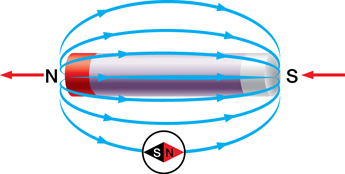
You were also introduced to the hand rules. You can use hand rules to determine the direction of magnetic fields surrounding a current-carrying wire or through a cold of wire (solenoid).
Lastly, you learned that the connection between moving charge and the production of magnetic fields is the first step in understanding electromagnetism observed in nature and used in modern technologies such as electrical generators and motors.
In Lesson 2 you discovered that when a charged particle moves in an external magnetic field, it exhibits uniform circular motion. The inward force is a magnetic force that is proportional to the product of the particle’s speed (perpendicular to the magnetic field) and charge, and the strength of the magnetic field in which it moves. Expressed mathematically it is
![]()
You also learned how to predict the direction of the magnetic force using hand rules when you know the direction of the particle’s velocity and the direction of the magnetic field.
In Lesson 3 you learned that in a perpendicular magnetic field, a magnetic force is generated when a current-carrying conductor is located in a perpendicular magnetic field, which is similar to that of a moving charge.
You will investigate how the direction and magnitude of the magnetic force acting on a current-carrying conductor is determined, respectively, by hand rules and the product of the current, length of wire, and strength of the perpendicular magnetic field. Expressed mathematically it is
![]()
You also discovered why the direct current electric motor is essentially an electric generator in reverse. When a conductor is forced through a perpendicular magnetic field, a current is induced in the wire. This is known as the generator effect. Furthermore, the direction of the induced current is such that it produces a magnetic field that opposes the motion causing it. This is known as Lenz’s law.
Lastly, you explored how the motor effect and the generator effect are linked by the interaction of electric and magnetic fields.
All of the concepts presented in Module 4, along with the ones you learned in Module 3, will help you understand the nature and function of electrical generation and consumption.
 Module Assessment
Module Assessment
Question 1
Use the following information to answer this graphing question.
A student used the apparatus shown below to measure the radius of the curvature of the path of electrons as they pass through a magnetic field that is perpendicular to their path. This experimental design has the voltage as the manipulated variable, the speed calculated from the voltage, and the radius as the responding variable.
Accelerating Potential Difference (V) |
Speed (m/s) |
Radius (m) |
20.0 |
2.65 × 106 |
7.2 × 10–2 |
40.0 |
3.75 × 106 |
9.1 × 10–2 |
60.0 |
4.59 × 106 |
11.0 × 10–2 |
80.0 |
5.30 × 106 |
12.8 × 10–2 |
100.0 |
5.93 × 106 |
14.1 × 10–2 |
120.0 |
6.49 × 106 |
16.3 × 10–2 |
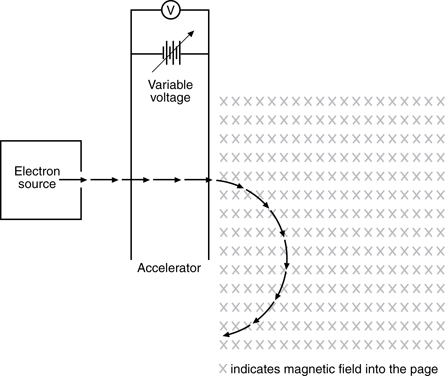
a. Plot the graph of radius as a function of speed, and construct a best-fit line.
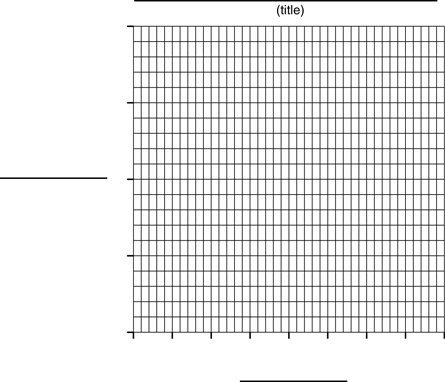
b. Using the slope or other appropriate averaging technique, determine the strength of the magnetic field.
c. Derive the equation that would allow you to calculate the speed of the electrons from the accelerating potential.
Graphing
(5 marks)
Scoring Guides for Graphing Skill-Based Questions––Mathematical Treatment
Score |
Description |
5 |
Note: One minor error may be present.* |
4 |
or
|
3 |
|
2 |
|
1 |
|
0 |
|
*Minor errors include
- misreading a data value while interpolating or extrapolating up to one-half grid off
- stating the final answer with incorrect (but not disrespectful) units
- stating the final answer with incorrect (but not disrespectful) significant digits
- missing one of several different formulas
**Implicit treatment means
- substituting appropriate values into a formula from the data sheets without stating the formula
- starting with memorized, derived formulas not given on the equations sheet
- substituting the value from one calculation into a second formula without communicating that the physics quantity in the two formulas is the same
***Major errors include
- using off-line points (Most often, this is calculating the slope using data points that are not on a linear line of best fit.)
- using a single data point ratio as the slope
- missing powers of 10 in interpolating or extrapolating
Question 2
Use the following information to answer this holistic question.
A teacher demonstrates how magnets can be used to create a current. The teacher attaches a coil of wire to a retort stand. The ends of the coil are attached to an ammeter. The teacher then drops a strong, rare, earth magnet through the coil. The students observe the movement of the ammeter and graph the results.
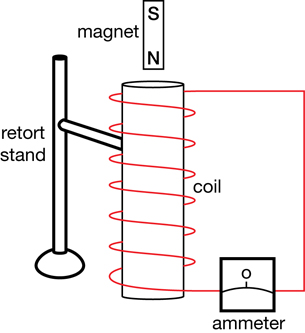
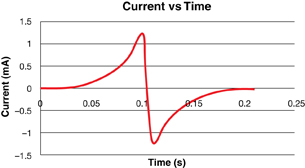
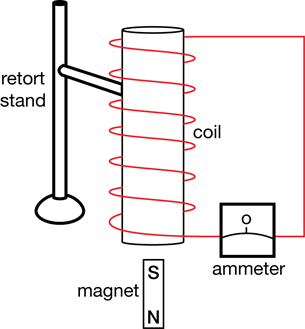
Analyze the students’ observations by
- describing the energy conversions (kinetic energy, gravitational potential energy, and electric energy) that occur in the magnet and coil system
- labelling the north and south magnetic poles induced in the coil in each picture (Justify your labels.)
- identifying and explaining the direction of the current as shown on the graph
Holistic Scoring Guide
Major Concepts: Magnetic and electric fields |
|
Score |
Description |
5 |
The nature of a response that will receive a score of 5 has the following characteristics:
Note: The response may contain minor errors or have minor omissions. |
4 |
The nature of a response that will receive a score of 4 has the following characteristics:
Note: The response is mostly complete and mostly correct, although it may contain errors or have omissions, and contains some application of physics principles. |
3 |
The nature of a response that will receive a score of 3 has the following characteristics:
|
2 |
The nature of a response that will receive a score of 2 has the following characteristic:
|
1 |
The nature of a response that will receive a score of 1 has the following characteristic:
|
0 |
The student provides a solution that is invalid for the question. |
* Explicit means the response is clearly stated; the marker does not have to interpret.
** Implicit (implied) means the response is not clearly stated; the marker must interpret.
For example,
Explicit: An electron has a negative charge while a proton has a positive charge.
The answer is clear with no possible misinterpretation.
Implicit: An electron has a negative charge while a proton does not.
The answer is not clear because the marker does not know whether a proton is neutral or positively charged. There is more than one possible way to interpret the answer.